Lexus GX460 2019 Owner's Manual / LEXUS 2019 GX460 OWNER'S MANUAL (OM60Q84U)
Manufacturer: LEXUS, Model Year: 2019, Model line: GX460, Model: Lexus GX460 2019Pages: 636, PDF Size: 11.11 MB
Page 371 of 636
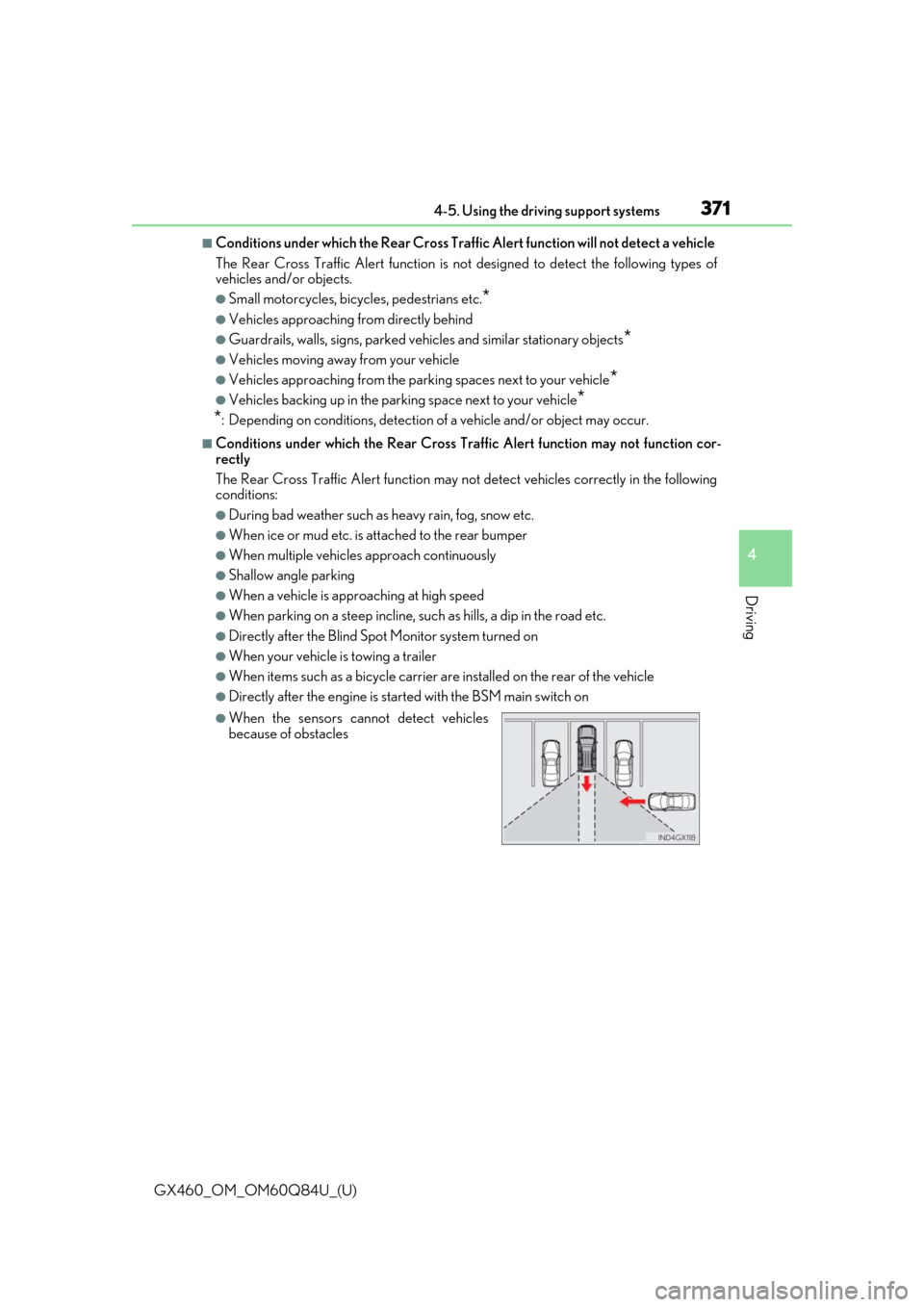
GX460_OM_OM60Q84U_(U)
3714-5. Using the driving support systems
4
Driving
■Conditions under which the Rear Cross Traffic Alert function will not detect a vehicle
The Rear Cross Traffic Alert function is no t designed to detect the following types of
vehicles and/or objects.
●Small motorcycles, bicycles, pedestrians etc.*
●Vehicles approaching from directly behind
●Guardrails, walls, signs, parked vehi cles and similar stationary objects*
●Vehicles moving away from your vehicle
●Vehicles approaching from the parking spaces next to your vehicle*
●Vehicles backing up in the parking space next to your vehicle*
*
: Depending on conditions, detection of a vehicle and/or object may occur.
■Conditions under which the Re ar Cross Traffic Alert function may not function cor-
rectly
The Rear Cross Traffic Alert function may no t detect vehicles correctly in the following
conditions:
●During bad weather such as heavy rain, fog, snow etc.
●When ice or mud etc. is attached to the rear bumper
●When multiple vehicles approach continuously
●Shallow angle parking
●When a vehicle is approaching at high speed
●When parking on a steep incline, su ch as hills, a dip in the road etc.
●Directly after the Blind Spot Monitor system turned on
●When your vehicle is towing a trailer
●When items such as a bicycle carrier ar e installed on the rear of the vehicle
●Directly after the engine is started with the BSM main switch on
●When the sensors cannot detect vehicles
because of obstacles
Page 372 of 636
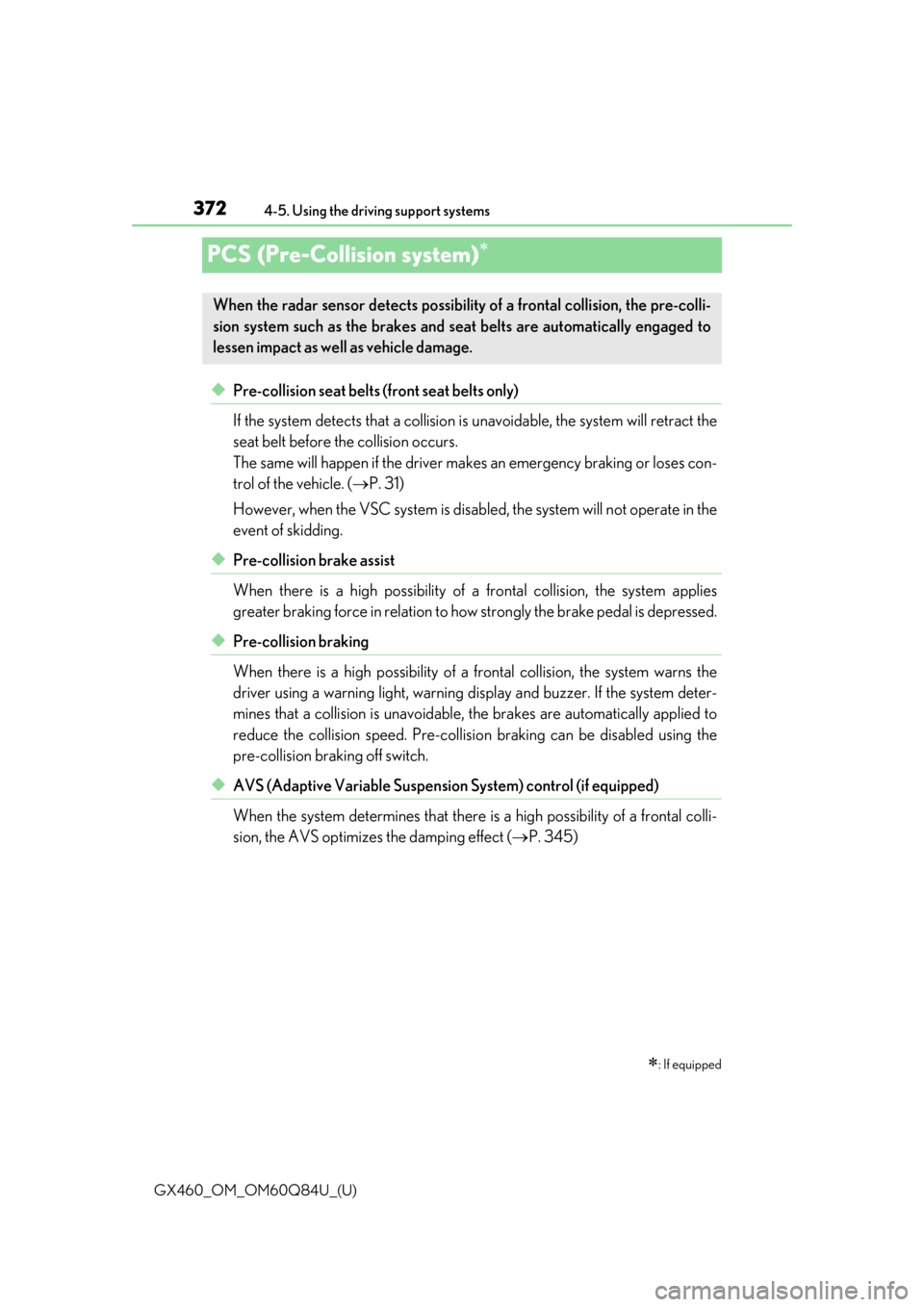
372
GX460_OM_OM60Q84U_(U)4-5. Using the driving support systems
PCS (Pre-Collision system)
◆Pre-collision seat belts (front seat belts only)
If the system detects that a collision is
unavoidable, the system will retract the
seat belt before the collision occurs.
The same will happen if the driver makes an emergency braking or loses c\
on-
trol of the vehicle. ( P. 31)
However, when the VSC system is disabl ed, the system will not operate in the
event of skidding.
◆Pre-collision brake assist
When there is a high possibility of a frontal collision, the system applies
greater braking force in relation to how strongly the brake pedal is depressed.
◆Pre-collision braking
When there is a high possibility of a frontal collision, the system warns the
driver using a warning light , warning display and buzzer. If the system deter-
mines that a collision is unavoidable, the brakes are automatically applied to
reduce the collision speed. Pre-collisio n braking can be disabled using the
pre-collision braking off switch.
◆AVS (Adaptive Variable Suspension System) control (if equipped)
When the system determines that there is a high possibility of a frontal colli-
sion, the AVS optimizes the damping effect ( P. 345)
: If equipped
When the radar sensor detects possibilit y of a frontal collision, the pre-colli-
sion system such as the brakes and se at belts are automatically engaged to
lessen impact as well as vehicle damage.
Page 373 of 636
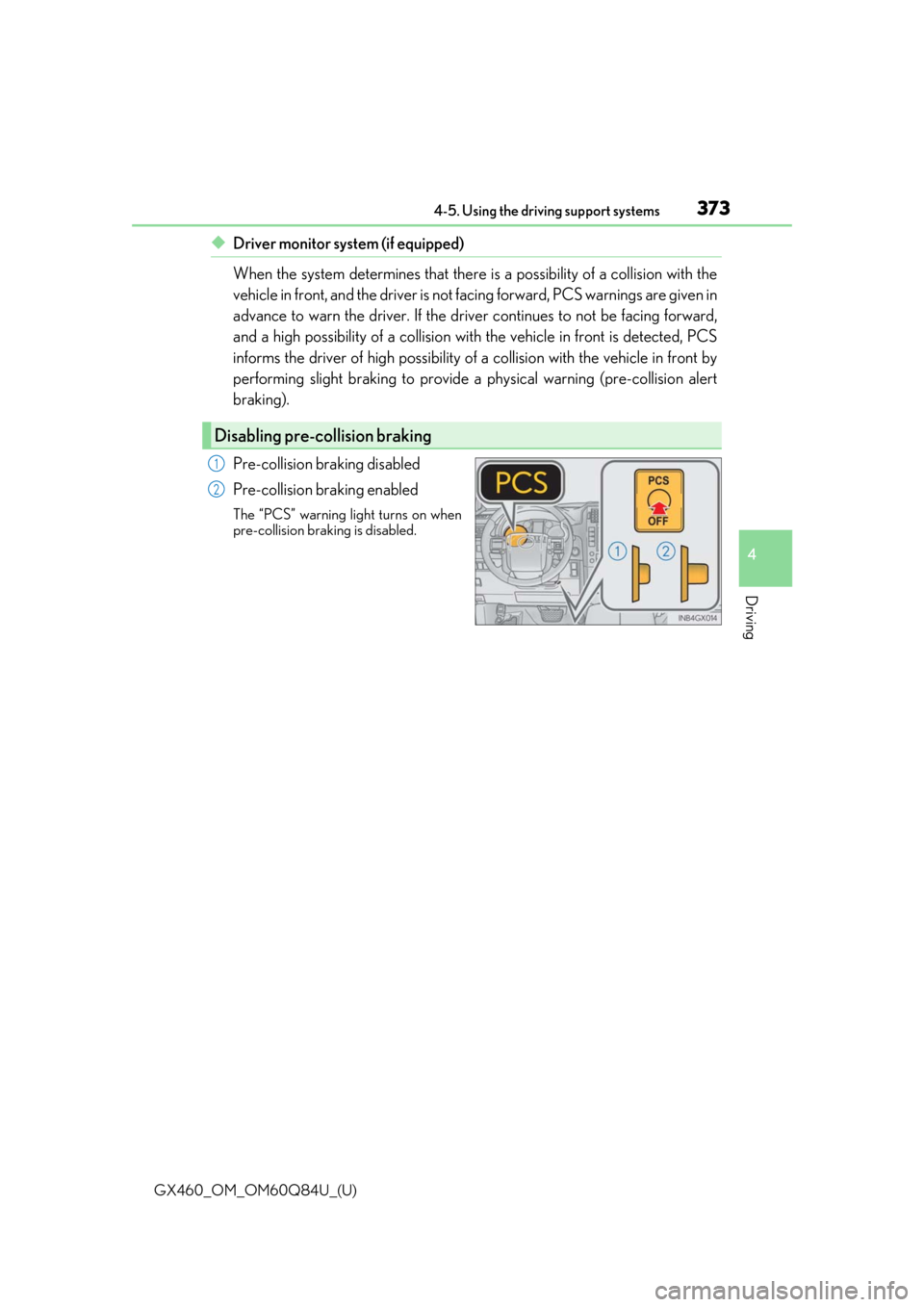
GX460_OM_OM60Q84U_(U)
3734-5. Using the driving support systems
4
Driving
◆Driver monitor system (if equipped)
When the system determines that there is a possibility of a collision with the
vehicle in front, and the driver is not facing forward, PCS warnings are given in
advance to warn the driver. If the driv er continues to not be facing forward,
and a high possibility of a collision with the vehicle in front is detected, PCS
informs the driver of high possibility of a collision with the vehicle in front by
performing slight braking to provide a physical warning (pre-collision alert
braking).
Pre-collision braking disabled
Pre-collision braking enabled
The “PCS” warning light turns on when
pre-collision braking is disabled.
Disabling pre-collision braking
1
2
Page 374 of 636
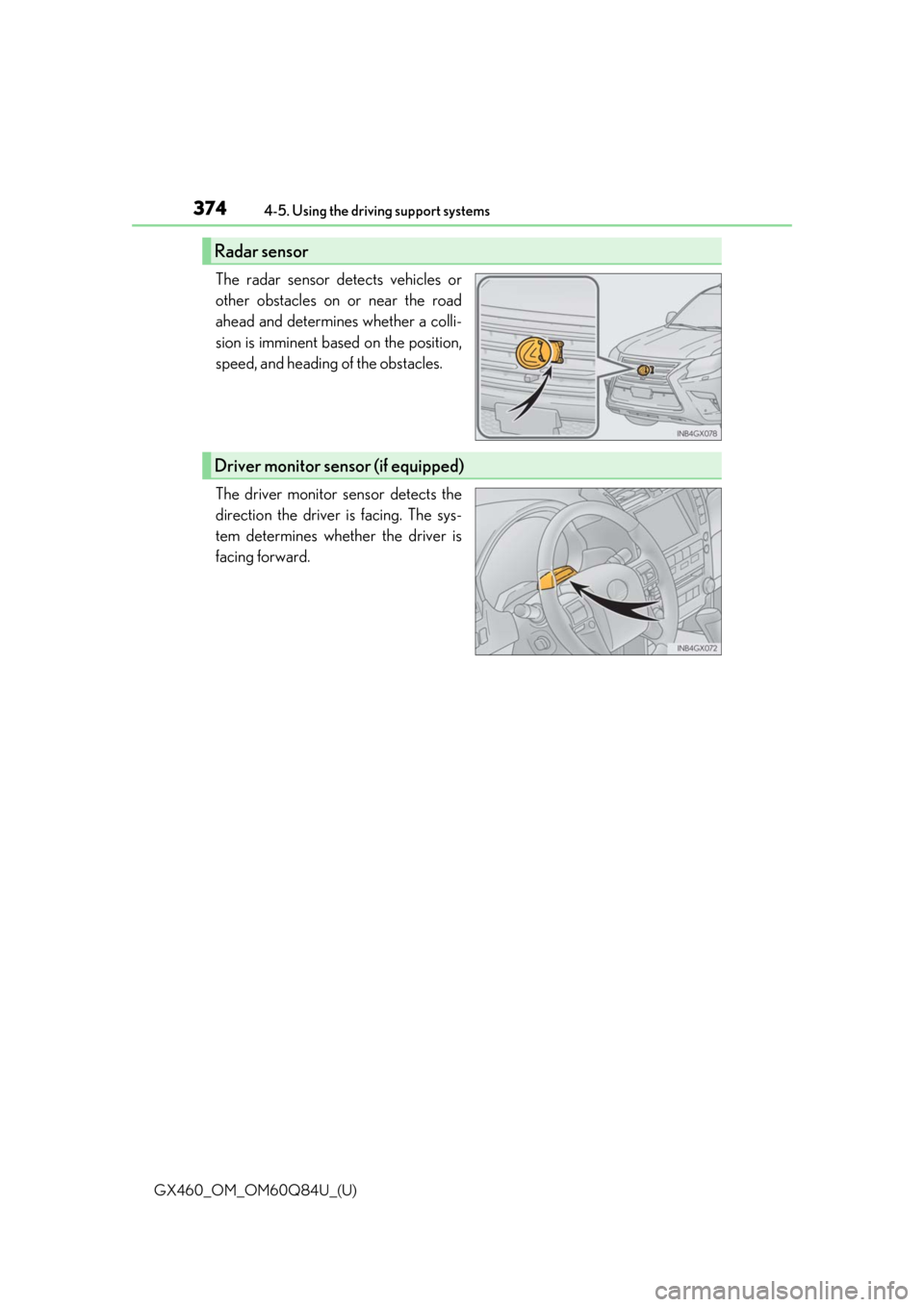
374
GX460_OM_OM60Q84U_(U)4-5. Using the driving support systems
The radar sensor detects vehicles or
other obstacles on or near the road
ahead and determines whether a colli-
sion is imminent based on the position,
speed, and heading of the obstacles.
The driver monitor sensor detects the
direction the driver is facing. The sys-
tem determines whether the driver is
facing forward.
Radar sensor
Driver monitor sensor (if equipped)
Page 375 of 636
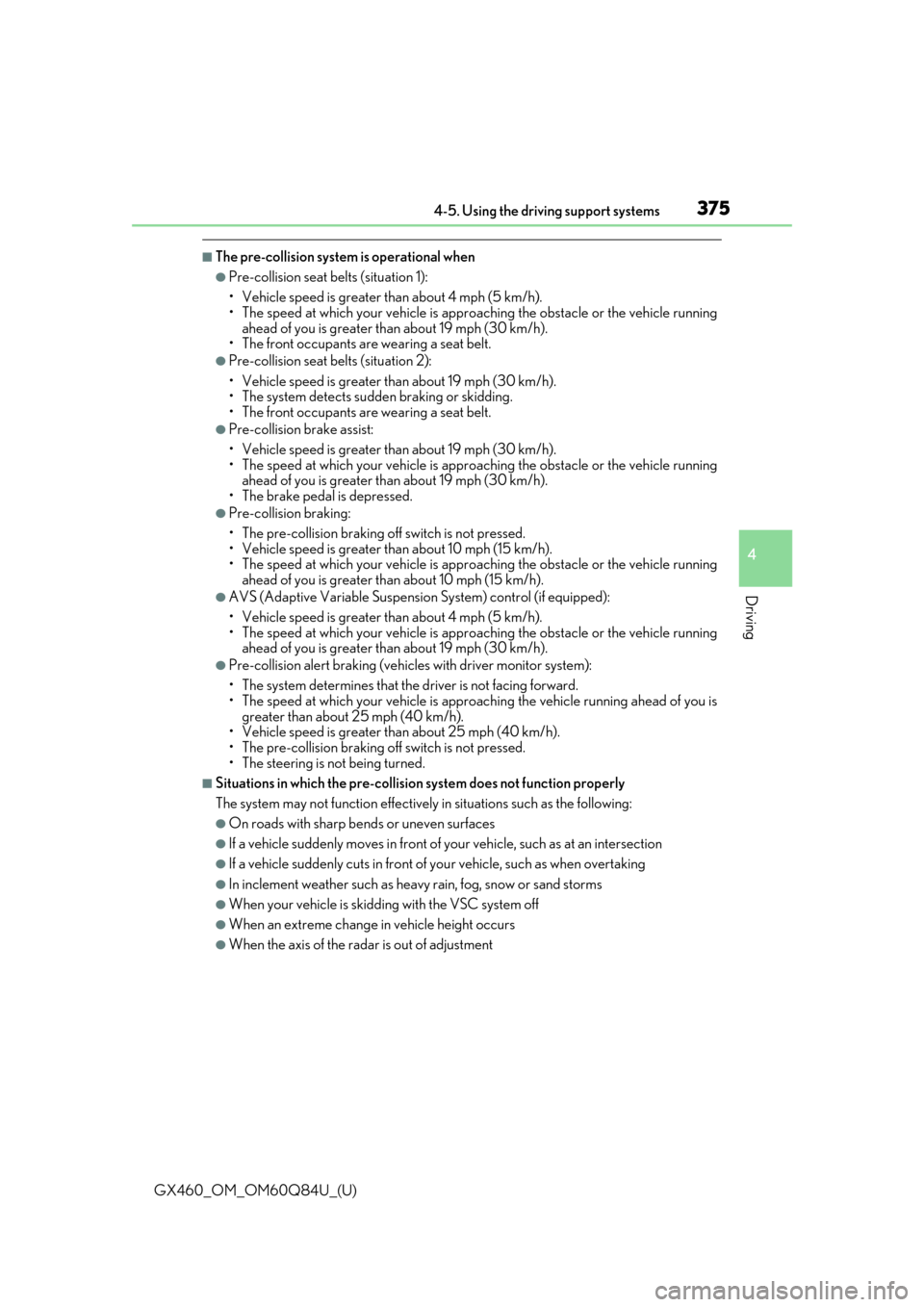
GX460_OM_OM60Q84U_(U)
3754-5. Using the driving support systems
4
Driving
■The pre-collision system is operational when
●Pre-collision seat belts (situation 1):
• Vehicle speed is greater than about 4 mph (5 km/h).
• The speed at which your vehicle is approaching the obstacle or the vehicle running ahead of you is greater than about 19 mph (30 km/h).
• The front occupants are wearing a seat belt.
●Pre-collision seat belts (situation 2):
• Vehicle speed is greater th an about 19 mph (30 km/h).
• The system detects sudden braking or skidding.
• The front occupants are wearing a seat belt.
●Pre-collision brake assist:
• Vehicle speed is greater th an about 19 mph (30 km/h).
• The speed at which your vehicle is approaching the obstacle or the vehicle running ahead of you is greater than about 19 mph (30 km/h).
• The brake pedal is depressed.
●Pre-collision braking:
• The pre-collision braking off switch is not pressed.
• Vehicle speed is greater th an about 10 mph (15 km/h).
• The speed at which your vehicle is approaching the obstacle or the vehicle running
ahead of you is greater than about 10 mph (15 km/h).
●AVS (Adaptive Variable Suspension System) control (if equipped):
• Vehicle speed is greater than about 4 mph (5 km/h).
• The speed at which your vehicle is approaching the obstacle or the vehicle running ahead of you is greater than about 19 mph (30 km/h).
●Pre-collision alert braking (vehic les with driver monitor system):
• The system determines that the driver is not facing forward.
• The speed at which your vehicle is appr oaching the vehicle running ahead of you is
greater than about 25 mph (40 km/h).
• Vehicle speed is greater th an about 25 mph (40 km/h).
• The pre-collision braking off switch is not pressed.
• The steering is not being turned.
■Situations in which the pre-collision system does not function properly
The system may not function effectively in situations such as the following:
●On roads with sharp bends or uneven surfaces
●If a vehicle suddenly moves in front of yo ur vehicle, such as at an intersection
●If a vehicle suddenly cuts in front of your vehicle, such as when overtaking
●In inclement weather such as heavy rain, fog, snow or sand storms
●When your vehicle is skidding with the VSC system off
●When an extreme change in vehicle height occurs
●When the axis of the radar is out of adjustment
Page 376 of 636

376
GX460_OM_OM60Q84U_(U)4-5. Using the driving support systems
■Automatic cancelation of pre-collision system
When a malfunction occurs due to sensor contaminations, etc. that results in the sensors
being unable to detect obstac
les, the pre-collision system will be automatically disabled.
In this case, the system will not activate even if there is a collision possibility.
■Obstacles not detected
The system cannot detect plastic obstacles su ch as pylons. There may also be occasions
when the system cannot detect pedestrians, animals, bicycles, motorcycles, trees, or
snowdrifts.
■Conditions that may trigger th e system even if there is no possibility of a collision
In any of the following situations where the frontal area of the radar sensor is interrupted,
the radar sensor may de tect possibility of a frontal collis ion and the system may be acti-
vated.
●When passing by an oncoming vehicle in a curve or a turn to the right or the left
●When rapidly approaching an obstacle ahead (e.g. preceding vehicle, toll gate barrier,
etc.)
●When there is a structural object (billboar d, low ceiling, fluorescent light, etc.) above
the uphill road ahead
●When driving on a narrow road or throug h under a low overhead structure (bridge,
tunnel, fly-under, etc.)
●When driving on an uneven road surface
●When there is a metal object, bump, or protrusion on the road surface
●When vehicle’s front part is raised or lowered depending on loading conditions
●When the direction of radar sensor is misa ligned by strong impact applied on an area
around the radar sensor, etc.
●When there is an obstacle (guard rail, etc.) by the roadside at the entrance to a curve
●When the front of your vehicle is pointing upwards (caused by towing a trailer, during
emergency towing or putting a heavy lo ad in the luggage compartment etc.)
When the system is activated in the situations described above, there is also a possibility
that the seat belts w ill retract quickly and the brakes ma y be applied with a force greater
than normal. When the seat belt is locked in the restricted position, stop the vehicle in a
safe place, release the seat belt and refasten it.
■When there is a malfunction in the system, or if the system is temporarily unusable
Warning lights will turn on or flash, and warning messages will be displayed.
( P. 519, 530)
Page 377 of 636
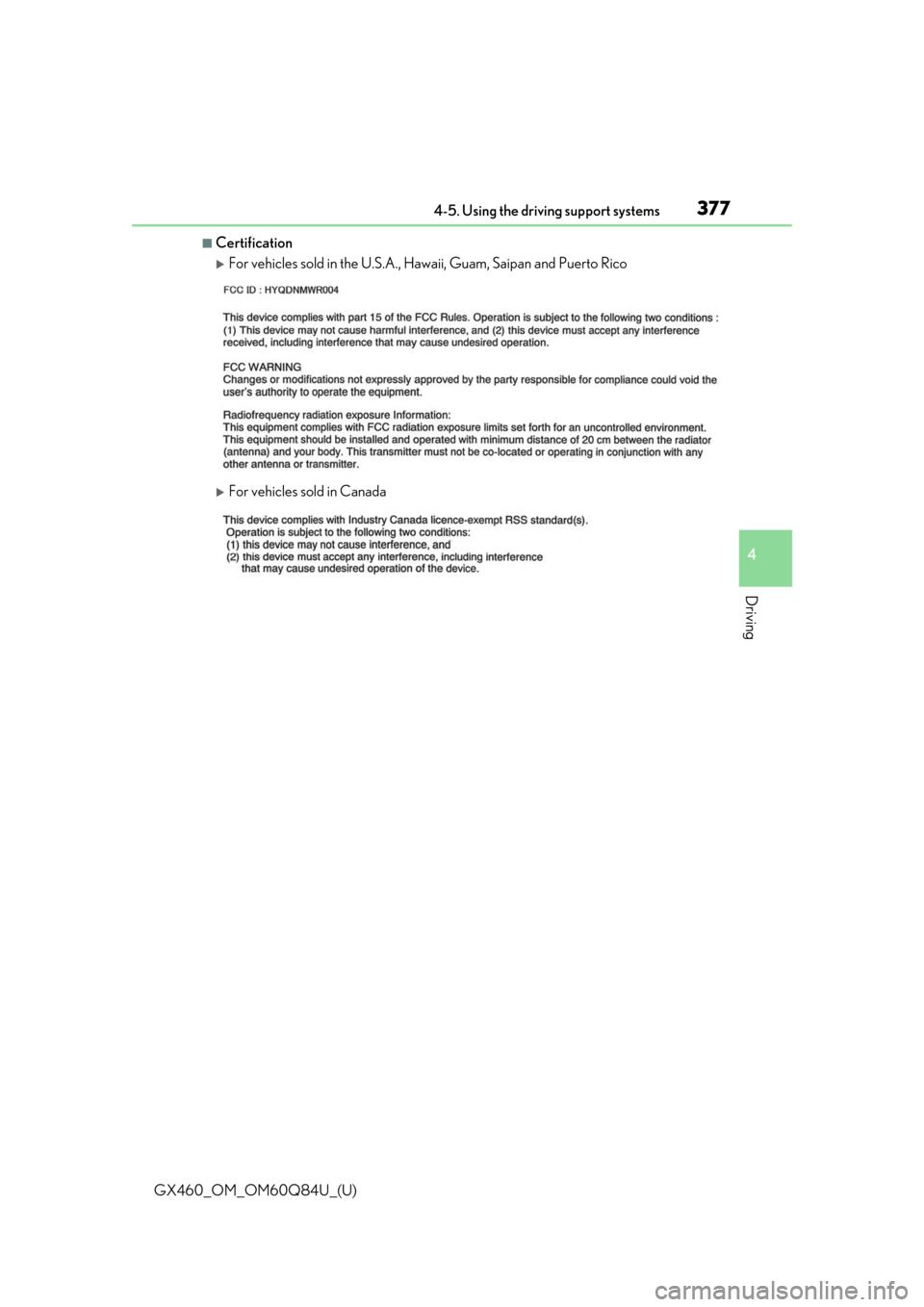
GX460_OM_OM60Q84U_(U)
3774-5. Using the driving support systems
4
Driving
■Certification
For vehicles sold in the U.S.A., Hawaii, Guam, Saipan and Puerto Rico
For vehicles sold in Canada
Page 378 of 636

378
GX460_OM_OM60Q84U_(U)4-5. Using the driving support systems
CAUTION
■Limitations of the
pre-collision system
The driver is solely responsible for safe driving. Always drive safely, taking care to
observe your surroundings.
Do not use the pre-collision system instead of normal braking operations under any
circumstances. This system will not prevent collis ions or lessen damage or injuries in all
cases. Do not overly rely on this system. Failure to do so may cause an accident, result-
ing in death or serious injury.
This system has been designed to help avoid and redu ce the impact of collisions. How-
ever, the system operates differently depending on the situation ( P. 375, 376). As a
result, the same level of performance may no t be expected in all cases. Also, the pre-
collision brakes may not operate if the driver is depressing the brake pedal or turning
the steering wheel, as the sy stem will determine such conditions as collision avoidance
operations.
■Cautions regarding the assist contents of the system
By means of alarms and brake control, the pr e-collision system is intended to assist the
driver in avoiding collisions through the process of LOOK-JUDGE-ACT. There are
limits to the degree of assistance the system can provide, so please keep in mind the
following important points.
●Assisting the driver in watching the road
The pre-collision system is only able to detect obstacles directly in front of the vehicle,
and only within a limited range. It is not a mechanism that allows careless or inatten-
tive driving, and it is not a system that can assist the driver in low- visibility conditions. It
is still necessary for the driver to pay close attention to the vehicle’s surroundings.
●Assisting the driver in making correct judgment
When attempting to estimate the possibility of a collis ion, the only data available to
the pre-collision system is that from obstacles it has detected directly in front of the
vehicle. Therefore, it is absolutely necessa ry for the driver to remain vigilant and to
determine whether or not there is a possib ility of collision in any given situation.
●Assisting the driver in taking action
The pre-collision system’s braking assist feature is designed to help reduce the sever-
ity of a collision, and so only acts when the system has judged that a collision is
unavoidable. This system is not capable of automatically avoiding a collision or bring-
ing the vehicle to a stop safely without appropriate operations performed by the
driver. For this reason, when encountering a dangerous situation the driver must take
direct and immediate action in order to ensure the safety of all involved.
Page 379 of 636
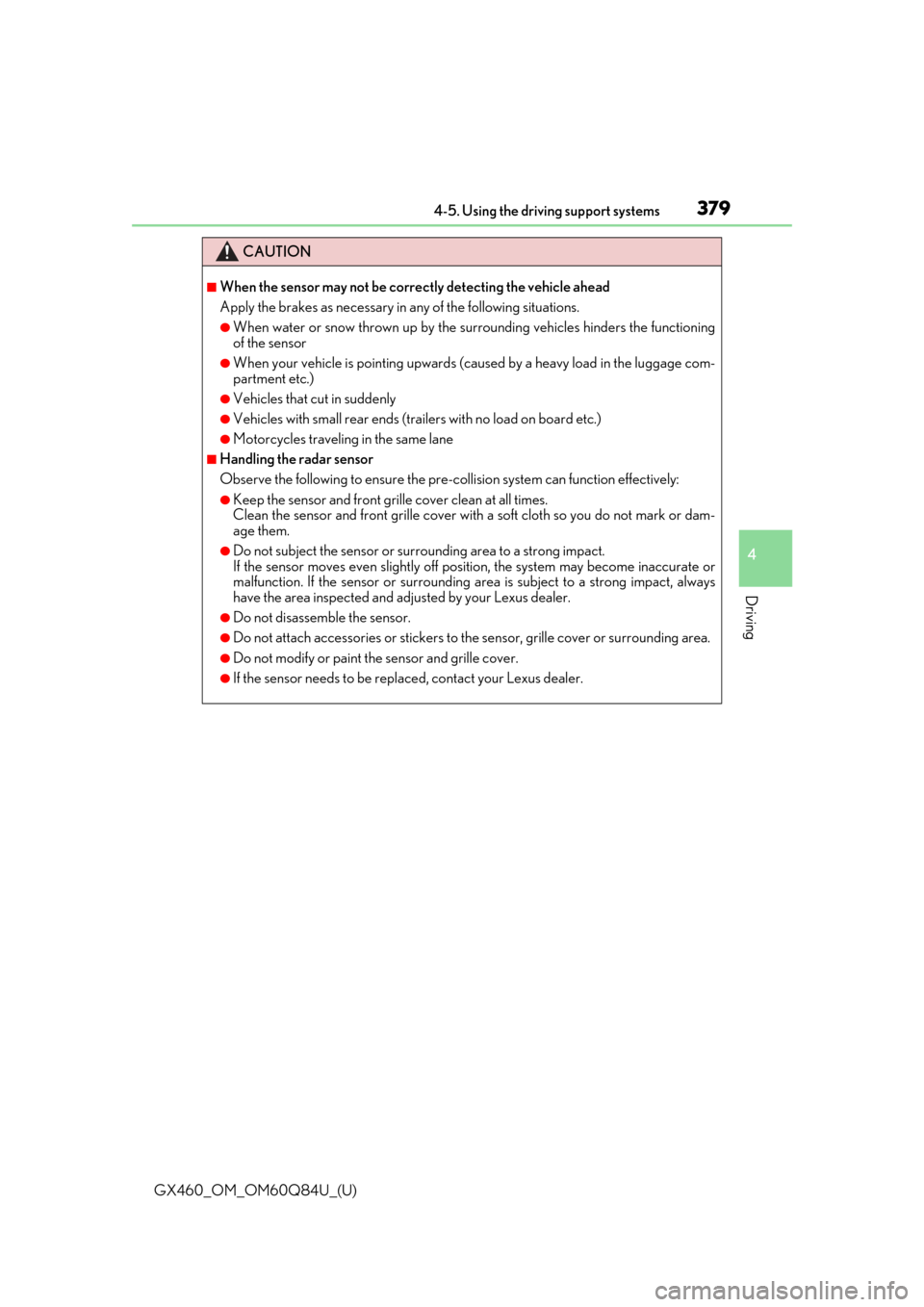
GX460_OM_OM60Q84U_(U)
3794-5. Using the driving support systems
4
Driving
CAUTION
■When the sensor may not be correctly detecting the vehicle ahead
Apply the brakes as necessary in any of the following situations.
●When water or snow thrown up by the surrounding vehicles hinders the functioning
of the sensor
●When your vehicle is pointing upwards (caused by a heavy load in the luggage com-
partment etc.)
●Vehicles that cut in suddenly
●Vehicles with small rear ends (tra ilers with no load on board etc.)
●Motorcycles traveling in the same lane
■Handling the radar sensor
Observe the following to ensure the pre-collision system can function effectively:
●Keep the sensor and front grille cover clean at all times.
Clean the sensor and front grille cover with a soft cloth so you do not mark or dam-
age them.
●Do not subject the sensor or surrounding area to a strong impact.
If the sensor moves even s lightly off position, the system may become inaccurate or
malfunction. If the sensor or surrounding area is subject to a strong impact, always
have the area inspected and adjusted by your Lexus dealer.
●Do not disassemble the sensor.
●Do not attach accessories or stickers to the sensor, grille cover or surrounding area.
●Do not modify or paint the sensor and grille cover.
●If the sensor needs to be replaced, contact your Lexus dealer.
Page 380 of 636
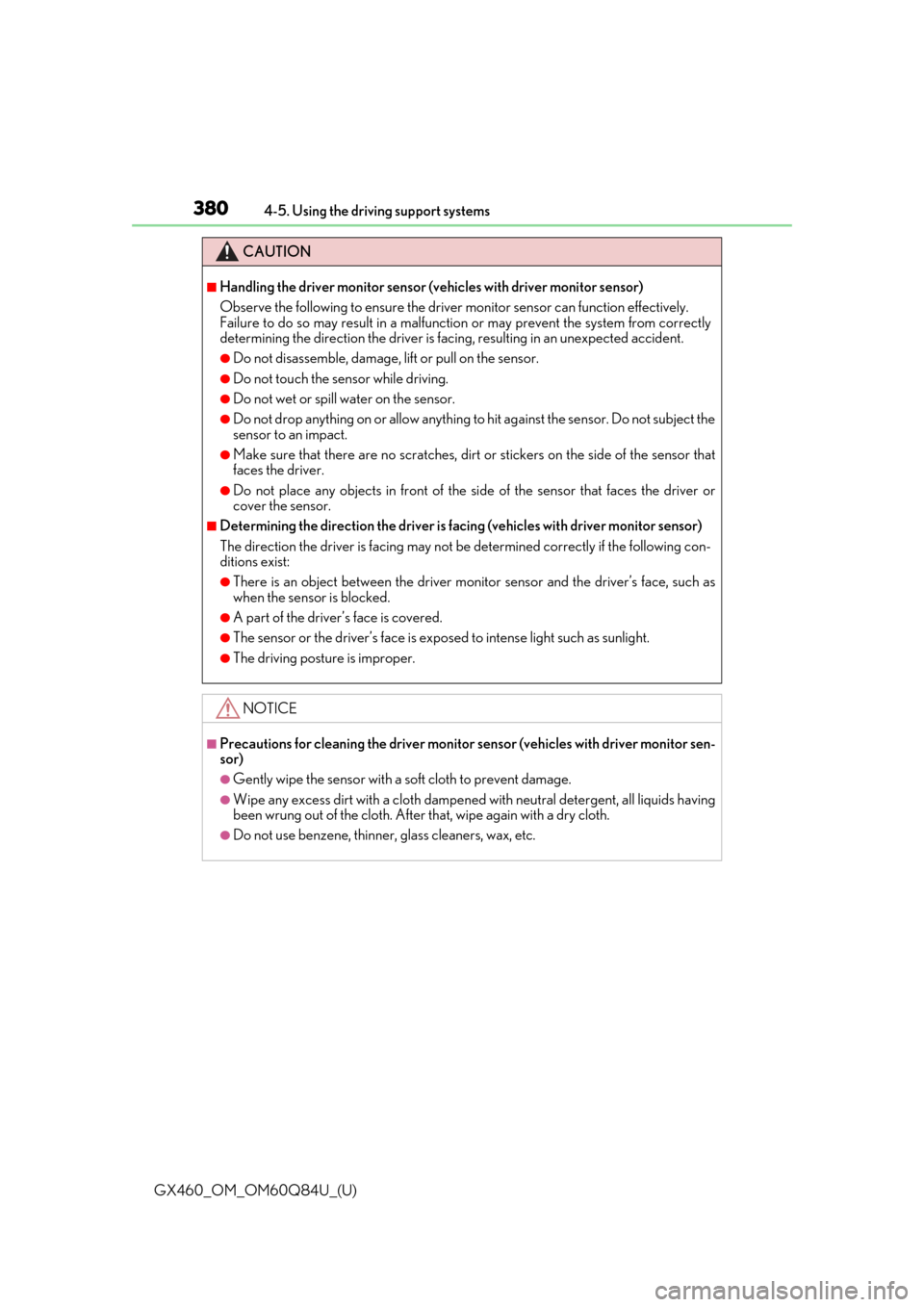
380
GX460_OM_OM60Q84U_(U)4-5. Using the driving support systems
CAUTION
■Handling the driver monitor sensor (v
ehicles with driver monitor sensor)
Observe the following to ensure the driver monitor sensor can function effectively.
Failure to do so may result in a malfunct ion or may prevent the system from correctly
determining the direction the driver is facing, resulting in an unexpected accident.
●Do not disassemble, damage, lift or pull on the sensor.
●Do not touch the sensor while driving.
●Do not wet or spill water on the sensor.
●Do not drop anything on or allow anything to hit against the sensor. Do not subject the
sensor to an impact.
●Make sure that there are no sc ratches, dirt or stickers on the side of the sensor that
faces the driver.
●Do not place any objects in front of the si de of the sensor that faces the driver or
cover the sensor.
■Determining the direction the driver is faci ng (vehicles with driver monitor sensor)
The direction the driver is facing may not be determined correctly if the following con-
ditions exist:
●There is an object between the driver monitor sensor and the driver’s face, such as
when the sensor is blocked.
●A part of the driver ’s face is covered.
●The sensor or the driver’s face is expo sed to intense light such as sunlight.
●The driving posture is improper.
NOTICE
■Precautions for cleaning the driver monitor sensor (vehicles with driver monitor sen-
sor)
●Gently wipe the sensor with a soft cloth to prevent damage.
●Wipe any excess dirt with a cloth dampened with neutral detergent, all liquids having
been wrung out of the cloth. After that, wipe again with a dry cloth.
●Do not use benzene, thinner, glass cleaners, wax, etc.